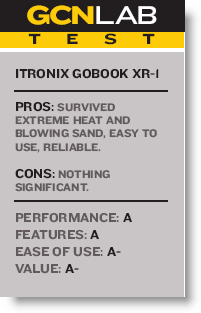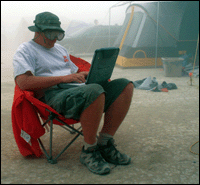EVERY AFTERNOON like clockwork, it seemed, the sandstorms would strike.The wind would start blowing and anything that wasn't tied down, such as an improperly secured tent, would fly away.One day, the winds were so heavy that the sky became indistinguishable from the ground ' all we could see was a wash of yellowish-orange flying sand and debris.Iraq? No, the 2007 Burning Man arts festival.Unfortunately, those afternoons were also the deadlines for a newspaper a group of us put together almost every day. With little in the way of shelter besides a tarp roof on a shack with no walls, and nothing to cover our freshly mixed gin and tonics, we had to keep typing away. We had journalism to do, dadgummit! This year, our job was made slightly easier thanks to one reliable piece of hardware ' the General Dynamics Itronix XR-1 rugged laptop PC.When it comes to extreme computing, few environments put more stress on a computer than the desert. U.S. troops in Iraq know that. So we took the opportunity to put the XR-1 rugged computer into a field environment of scorching sun and desert storms, where sand works its way into the crevices of every electronic component.Here is the back story: Each year, I head off to the desert to hang out with a bunch of other adventurous revelers. The location is the Black Rock Desert, just northeast of Reno, Nev.Thousands gather here the week before Labor Day to build a temporary town in the desert, called Black Rock City.Last year, more than 40,000 participants came out. The city is laid out in the flat bowl of a valley, called a playa. There is no sagebrush or sand dunes on the playa. The whole area is flat as a pancake. Just before the event, the organizers set up a series of city streets, put in place by water trucks that mat down the roadway with an application of water. The streets encircle a giant wooden effigy ' the actual 'Man' of Burning Man ' that will be torched at the end of the event.It is best to think of Burning Man as a kind of arts festival, though the organizers like to call it an exercise in radical self-expression.You must bring everything you need to survive, including at least a gallon of water for each day you are there.In 2007, I went with a group known as Spock Mountain Research Labs (SMRL). 'World Leaders in Beverage Science and Leisure Technology' is their motto. The thing that makes Burning Man so enjoyable is that everyone is encouraged to bring something that would provide amusement for the festivalgoers as a group ' perhaps a stunning work of art or a service, such as pancake breakfasts. 'No spectators' is one of the unofficial mottoes. My own contribution to this event was to help run SMRL's newspaper, The Spock Science Monitor, which we distributed throughout Black Rock City.Although the paper's news stories were rather whimsical ' we mostly made them up, actually ' they provided a running commentary of what was happening that week on the playa. And, like any real newspaper, we took much delight in exposing the foibles of the governing body and our fellow attendees. But how does one make a newspaper in the middle of the desert? The enterprise has indeed left a long line of damaged, sandblasted equipment.First of all, there are no electrical outlets in the desert, of course. We had to bring a generator.Fortunately, Coleman offers a 2,200-watt portable generator that offered plenty of power, though it probably was not clean. To print the paper, other SMRLers had acquired a used copy machine and an old Apple printer, both kept in one guy's Airstream trailer to protect them from the elements.As for computers, we quickly discovered in years past that they will operate, though not very well, in this climate. The first year, a Macintosh that was slated for production duties died in the heat. Over time, people learned to shade the machines from the storms and the sun. The newspaper staffs used laptops, and though they survived, playa sand would inevitably work into their many crevices, making them unpleasant to use later. Hinges didn't open and close smoothly, keys were sometimes reluctant to be pressed. Optical disk drives ground away in ominous tones.Would a rugged laptop work any better in this environment? After all, General Dynamics, which purchased rugged laptop maker Itronix in 2005, touts the laptops as able to work in extreme conditions. The market for these units is the military and law enforcement.The XR-1 has gone through Mil-Std 810F testing, so it should work comfortably in temperatures between negative 10 degrees Fahrenheit and 140 degrees Fahrenheit. It is sealed against water and dust intrusions, again meeting military specifications (Mil-Std 810F 506.4). It's also designed to withstand vibration (Mil-Std 810F 514.5 C-17 and C-18) and repeated three-foot drops (Mil-Std 810F 516.5).The conditions we worked in were not that severe, but we ran that machine hard for the week. Whenever a story came up, the unit came out. When it was not in use, we threw it into the cab of a pickup truck, where temperatures could routinely exceed 110 degrees. It got jostled around a lot, as different people used the machine during the week. One person would work on a story and pass the unit to another for editing.When we couldn't get our printer to work or something else went wrong, I often jumped on a bike and, laptop in hand, rode off to solve the problem elsewhere in the city.Although I hadn't planned to use the machine when the winds picked up, dust storms happened so often that I had no choice. By the time the week had ended, the unit was covered in a fine patina of playa dust.With a fair amount of coddling, a standard laptop can survive in this environment, but it will never be the same afterward.The XR-1, however, worked just as well at the end of the week as it did in the beginning.Moreover, it was a pleasure to use. In this environment, most regular laptops often get too hot to use on your lap. And their flimsiness leaves you worried about their survivability.The XR-1 felt solid. One member of our group liked to call it the Tonka Toy computer because it did feel like a kid's computer. It has a sturdy plastic carrying handle, which made it easy to tote around. The hinges opened and shut smoothly even after a week of use. The keyboard is nicely laid out, and the keys are easy to read, with black letters on a white background.The Touchpad remained responsive after an entire week.And the cooling aspect worked exceptionally well. Even as the ambient temperature soared into the 90s, the unit never got too hot to place in your lap. Its speediness also was attractive.This model had a 1.83 GHz Intel Core Duo processor, with 512M of RAM. Opening large image files was a snap. In a situation like this, when we were working as though we were in an office but were hundreds of miles from the nearest real one, the $3,381 price would be worth it.One of the unit's nifty features is that all the openings that you'd normally expect on a laptop, such as USB ports and optical drives, have plastic covers that snap shut, keeping them safe from the vagaries of the environment.They were easy to open whenever we had to transfer some material via a memory stick.General Dynamics added some other thoughtful features, too. When trying to set up the printer, we appreciated how the Ethernet controller could sense the need for and mimic a crossover cable, which we forgot to bring even though we were plugging directly into the printer. In dire working conditions, such additions are welcome.The touch screen was a novelty for us, and it remained responsive through the week ' although in all honesty, we rarely used it because we were so trained in using the trackpad. And though we usually avoided working in direct sunlight for obvious reasons, the display was bright enough to see ' and brighter than a normal laptop ' even in sunny conditions.Before the event, General Dynamics sent over a prototype of their MR-1 model, a rugged ultra-mobile pc which has the DynaVue all-light viewable display technology. DynaVue provides outdoor viewability, even in direct sunlight, by using a filtering technology rather than relying on brute force display brightness, which keeps overall power use low.Even in sunlight, the display looked like a painting or photograph. It was amazing.Mostly, though, the Itronix was useful for how well it worked like a regular laptop.Battery life ran five or six hours, about on par with today's models, and the unit charged quickly in a few hours.We had some problems with starting the unit again after it went into hibernation, a well-known problem we suspected was with Windows XP and not the hardware. 'There's not much to say about it, really,' one member of our team noted. 'It does all the things a standard computer does, but in harsh conditions.' He added, cynically, that thanks to the XR-1, we have all the joys of running Microsoft Windows XP in the desert ' for better or worse. SMRLers tend toward Linux.But this unexceptional nature is fine. As an Army veteran, I know how extreme working conditions can get in the field. The last thing anyone needs to do is coddle electronic equipment in the heat of operations. Sure, Burning Man was fun. But we put the XR-1 through a heavy daily workload and stored it in extremely hot conditions. And based on that week, I can say I'd trust the XR-1 in a combat situation.
DUST IN THE WIND: GCN's Joab Jackson, working amid a sandstorm in Black Rock City, Nev., found the Itronix XR-1's rugged design and bright screen came in handy.
 Making the roundsTo extremesGeneral Dynamics Itronix, (800) 441-1309, www.gd-itronix.com.
Making the roundsTo extremesGeneral Dynamics Itronix, (800) 441-1309, www.gd-itronix.com.








